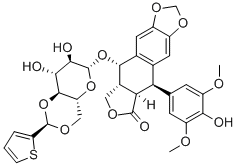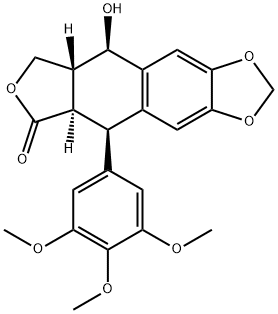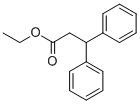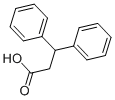A7806112
Teniposide , ≥98% , 29767-20-2
Synonym(s):
4′-Dimethyl-9-(4,6-O-2-thenyid)-epipodophyllotoxin;Tenoposide;VM-26
CAS NO.:29767-20-2
Empirical Formula: C32H32O13S
Molecular Weight: 656.65
MDL number: MFCD00866516
EINECS: 249-831-2
| Pack Size | Price | Stock | Quantity |
| 20mg | RMB191.20 | In Stock |
|
| 25MG | RMB204.00 | In Stock |
|
| 100MG | RMB628.00 | In Stock |
|
| 500mg | RMB2036.80 | In Stock |
|
| others | Enquire |
Update time: 2022-07-08
PRODUCT Properties
| Melting point: | 244-247°C |
| Boiling point: | 650.86°C (rough estimate) |
| alpha | D20 -107° (9:1 chloroform/methanol) |
| Density | 1.2568 (rough estimate) |
| refractive index | 1.5530 (estimate) |
| storage temp. | -20°C |
| solubility | DMSO: soluble10mg/mL, clear |
| pka | 10.13(at 25℃) |
| form | powder |
| color | white to beige |
| optical activity | [α]/D -100 to -115°, c = 1 in chloroform/methanol (9:1) |
| λmax | 283nm(MeOH)(lit.) |
| Merck | 14,9145 |
| Stability: | Hygroscopic |
| CAS DataBase Reference | 29767-20-2(CAS DataBase Reference) |
| IARC | 2A (Vol. 76) 2000 |
Description and Uses
Teniposide is a podophyllotoxin derivative that causes dose-dependent single- and double-stranded breaks in DNA by inhibiting topoisomerase II. Its cytostatic effects are related to its ability to stabilize the DNA-topoisomerase II complex during DNA replication, inducing DNA damage and cellular apoptosis. Teniposide has been widely used in the treatment of various cancers including, small cell lung cancer, malignant lymphoma, breast cancer, oral squamous cell carcinoma, and acute lymphoblastic leukemia.
Safety
| Symbol(GHS) |  GHS08 |
| Signal word | Warning |
| Hazard statements | H341-H412 |
| Precautionary statements | P202-P273-P280-P308+P313-P405-P501 |
| Hazard Codes | Xi,T |
| Risk Statements | 36/37/38-45 |
| Safety Statements | 26-36-45-53 |
| RIDADR | UN 2811 6.1 / PGIII |
| WGK Germany | 3 |
| RTECS | KC0180000 |
| HS Code | 29349990 |
| Hazardous Substances Data | 29767-20-2(Hazardous Substances Data) |
| Toxicity | LD50 intraperitoneal in mouse: 29570ug/kg |





